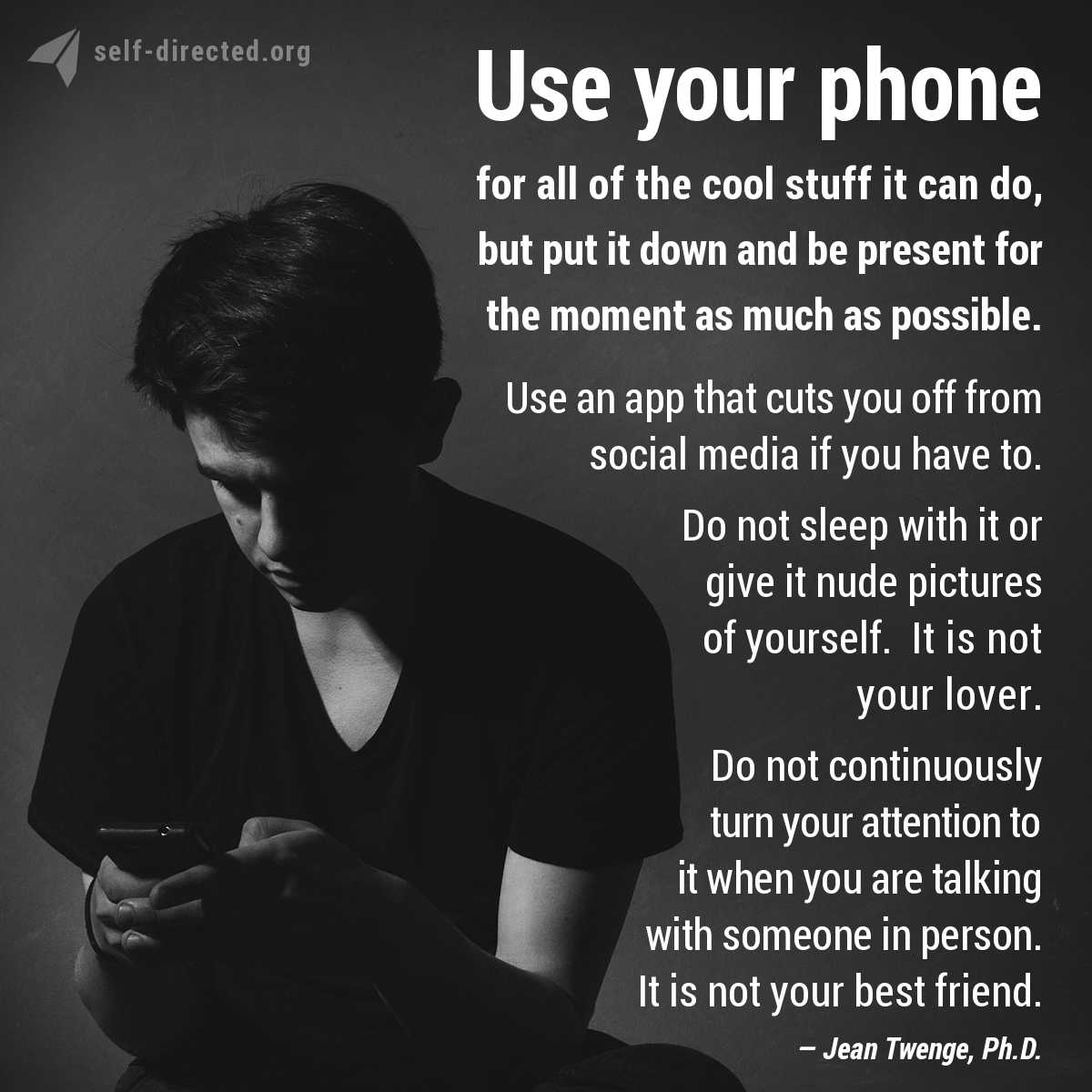Here’s a noncontroversial fact: The sun will rise tomorrow.
Here’s another: If you give a young person more unrestricted free time, there’s a good chance they’ll spend it on their phone, computer, or gaming system.
According to conventional wisdom, this is a problem. Screen time and social media are dangerous new technologies that deserve to be restricted by parents and doled out in careful, developmentally appropriate, measured doses.
But according to others — including many advocates of Self-Directed Education — screen time risks are overblown. The benefits of entertainment, gaming, and social media outweigh the downsides, and there’s no real need to worry. Restrictions do more harm than good, this crowd argues.
So who’s right? The answer is... it’s complicated.
According to Jean Twenge, Ph.D., and her 2017 book iGen: Why Today’s Super-Connected Kids Are Growing Up Less Rebellious, More Tolerant, Less Happy — and Completely Unprepared for Adulthood (find a copy at your local library) there are certain teenage mental health indicators that have suspiciously plummeted at the exact same time that smartphones gained popularity. The evidence is correlational, not causational, which means that it’s hard to point the finger directly at smartphones. But as you’ll soon see, it’s hard to find a more likely culprit.
Despite the clickbait title, Twenge is a solid academic and her book is backed by solid research. It will help you decide for yourself whether screens and social media are to blame for rising rates of depression and anxiety among teens.
Who is iGen?

Who is “iGen?” According to Twenge — who coined the term — it describes everyone born between 1995 and 2012. This is the first generation that grew up with the iPhone (released in 2007) and smartphones in general (the majority of Americans owned one starting in 2011). These are the kids who don’t remember a time before the Internet; the ones who were messaging each other long before hair started growing on weird parts of their bodies.
Twenge makes some pretty big claims about iGen, so she’d better have some pretty good sources. And she does. Twenge draws from four long-term studies of young people — questionnaires that have been given to middle schoolers, high schoolers, and college students for decades — to accurately compare iGen to previous generations.1 Her data sets are large, which is important for statistical significance, and they’re representative of the US population in terms of gender, race, location, and socioeconomic status.
Finally, Twenge is crystal clear that when she describes iGen, she’s dealing with averages, not individuals. When she makes claims about iGen, she’s talking about groups, not specific young people. So yes, it’s completely possible that your kid or your friends’ kids have stunningly positive mental health and show no addiction to screens. Twenge is not contradicting you. But she is saying that, for the average member of iGen, things are changing — and they’re changing in big ways.
The Changes
So what are these big changes? iGen is a long book with a seemingly endless number of data and graphs to pore over. Allow me to summarize Twenge’s most compelling findings into just four bullet points:
- Kids today are less likely to party, date, have sex, drive, hold a job, or drink alcohol than previous generations.
- High school seniors spend an average of six hours a day texting, Snapping, Instagramming, surfing the web, and gaming, and 97% of them use social media.
- Social media use correlates highly with teenage unhappiness, loneliness, sleep deprivation, and depression factors — and girls have the worst of it.
- In 2016, for the first time ever, the majority of new college students described their mental health as below average.
Whoa Nellie! And here’s the really fascinating part: Somewhere around 2007-2011 — right when smartphones started taking off — many of these indicators took a huge jump. (Take a quick peek at the graphs in Twenge’s article in The Atlantic to get a feeling for the trendlines.) This, essentially, is her argument: that the rapid adoption of smartphones (and corresponding rise in social media use) has led to major consequences for iGen.
But let’s not jump on the panic wagon just yet. First, let’s examine some interesting details and implications of these changes, and then we’ll discuss what we might do about all of it.
Growing Up Slowly
Okay, so teens today are less likely to go out to parties, have sex, or drink. Maybe this is a good thing, right? The teen birth rate hit an all-time low in 2015, for example. Nothing to complain about there. Maybe this means that today’s teens are actually more responsible and mature than previous generations? Or that they’re a bunch of boring prudes.
Twenge says that iGen is neither prudish nor better behaved. Instead, they are simply taking longer to grow up. This is a long-term trend happening across all Western nations, she reminds us, where parents are having fewer children, investing more time and money in each one, and giving kids more encouragement to cultivate a “self.” Just as the Millennials grew up more slowly than Generation X, Twenge reminds us that iGens are just following the long-term trend.

Twenge explains how a young person’s frontal cortex isn’t fully wired until age 25, and she acknowledges that iGen may need more protection for a longer time (see my summary of another book, The Teenage Brain, for more details). But she also reminds us that experience modifies our brains, and therefore the “still-developing brain” argument is actually a weak one. Perhaps today’s teens and young adults have an underdeveloped frontal cortex precisely because they have not been given adult responsibilities. “If brain scanners existed in 1950,” Twenge muses, “I wonder what they would have shown of a generation that usually started work at 18, married at 21, and had children soon after.”
I love this point. Just because a young person’s brain is still wiring — and just because kids are growing up more slowly in today’s culture — does not mean that any specific kid cannot shoulder larger responsibilities. Humans are highly adaptive creatures that can step up to big challenges when necessary, as adolescents from countless previous generations have demonstrated. While developmental stages clearly matter, it’s also clear that young people get better at making big decisions for themselves by making big decisions for themselves. We can help grease those neurons with myelin by giving young people real responsibilities as soon as they’re ready for them, not by treating them like porcelain dolls or unbaked bread.
Smartphone Mania and its Consequences
Twenge paints a fairly alarming picture of modern smartphone use: The typical teen sleeps with their phone by their sides, uses a phone about six hours a day, and checks notifications constantly. Girls spend more time on social media while boys tend toward gaming.
This is not just a middle-class or rich kid phenomenon. Disadvantaged teens spend just as much (or more) time online as those with more resources. “The smartphone era,” Twenge declares, “has meant the effective end of the Internet access gap by social class.”
Multitasking is now commonplace. One study installed a program on college students’ laptops that captured a screenshot every five seconds. The researchers found that students switched between tasks every 19 seconds on average, and more than 75% of the students’ computer windows were open less than a minute. Gone is the era of sitting and reading a book for hours without distraction — and unsurprisingly, Twenge reports, members of iGen read fewer print books for pleasure than any previous generation. Doing homework while watching Netflix while browsing Instagram while sending Snapchats is the new normal.
Twenge doesn’t condemn any of this as bad: It just is. She demonstrates remarkable restraint in describing iGen’s habits without judging them. But it’s hard not to judge when she begins to report on the decreasing mental health among teens who spend large amounts of time on social media. These teens report lower happiness, more loneliness, and more symptoms of depression. (Here some of the evidence is causational, not just correlational.) And it appears that the youngest teens, like eighth graders, are at the highest risk — especially those who spend 10 or more hours a week on social media.
The message from the data is loud and clear: Unhappiness, loneliness, and symptoms of depression are all positively correlated with high amounts of screen time, and they’re negatively correlated with exercise, face-to-face social interaction, religious services, and reading print media (i.e. paper books and magazines). The contrast is so stark, it’s ridiculous.
Girls are especially at risk: 48% more girls felt “left out” in 2015 than 2010, compared to a 27% increase for boys. They’re also twice as likely to experience cyber-bullying. Why is this? Twenge muses that
...social media [is] the perfect medium for the verbal aggression favored by girls. Even before the Internet, boys tended to bully one another physically and girls verbally. Social media give middle and high school girls a 24/7 platform to carry out the verbal aggression they favor, ostracizing and excluding other girls.
What about college students? On the American Freshman Survey, which surveys entering students, every indicator of negative mental health reached an all-time high in 2016: Today’s college students are more likely to report feeling depressed, overwhelmed, or anticipating need for counseling services than any previous generation.
Twenge observes that the sudden rise in depressive symptoms among young people occurred at almost the exact time that smartphones took off and in-person interaction began to plummet. Because this is correlational data, it’s possible that depressed people might simply use social media more often than non-depressed people. But why, then, have depression symptoms increased so rapidly and recently? The 2007-8 recession doesn’t explain it. Unemployment doesn’t explain it. Twenge paints smartphones as the most likely culprit. Whether they do this by reducing our face-to-face interactions, stealing our sleep, or by crippling us with FOMO (Fear of Missing Out) is unclear. But the broad correlation is clear: as smartphone and social media use has skyrocketed, mental health among young people has plummeted.
Twenge goes on to discuss many other changes in iGen’s attitudes and behavior — their religious beliefs, safety, employment, relationships, and politics — but the thrust of her argument remains focused on the link between screen time and mental health. So what can we do about it?
The Advice
Twenge makes a mind-boggling number of recommendations for navigating iGen as a parent; below I share a dozen of them. Written for a mainstream audience, much of Twenge’s advice is predictably control-oriented, but I’ll highlight some more positive strategies in the next section. My personal additions are noted in brackets.
- Wait as long as possible to give your kid a cell phone. A middle-school-aged child (e.g., an 11-year-old) doesn’t need anything more than a flip phone — and remember, it’s these tweens and younger teens who are most severely affected by high levels of social media consumption.
- If your middle-school-aged child wants to be on social media, go ahead and sign them up from your device, where you can limit access if necessary. Twenge reminds us that mental health issues are only associated with more than two hours of screen time a day.2 [She’s not clear about whether texting on a flip phone is considered “screen time”, but I suspect it’s not.]
- When you do get your kid a smartphone, install an app that limits that amount of time that they can spend on certain sites or apps.
- No one — including you, the parent — should sleep within ten feet of their phone. [And considering getting a wristwatch with an alarm clock function so that you truly have no need for a phone by your bedside.]
- When your kid wants to get on social media, encourage them to join Snapchat instead of Instagram or Facebook. Why? Because on Snapchat, posts are temporary and individual-to-individual. On Instagram and Facebook, posts are permanent and public. On Snapchat, there’s just a little less pressure to look perfect, a little less FOMO, and a little more freedom to make mistakes.
- If you’re working or studying, put your phone in a different room. Parents, you can be a model in this regard, and not just while working: Don’t pick up your phone during meals or conversations.

- Make it very clear to teenagers — even younger teens — that it’s never a good idea to send a nude picture of yourself. One mistake here can last for years.
- Encourage and enable your teens to hang out in person, and don’t judge them when it seems like they’re “not doing anything.” Face-to-face time with friends is crucial for teens’ mental health, and that’s when they build the real social skills that will serve them as adults. If driving them around is making you crazy, insist that your teen get a driver’s license [or start biking, or take public transport].
- Help your teens get sunlight, exercise, a diet high in omega-3 fatty acids, enough sleep, and lots of in-person social interaction. These are the basic building blocks for warding off anxiety and depression. For some, regular therapy and antidepressant medications will make a big difference too. [And don’t forget meditation.]
- Take the signs of teenage depression seriously, even in young children. Get an appointment with a professional if necessary. Rates of teenage suicide remain unacceptably high in the U.S., and it’s better to get help sooner than later.
- Protect your kid from bullying, including cyberbullying. Twenge is cautious with this recommendation, as she doesn’t think that any child could or should be protected from all harms (especially emotional harm), nor does she think safety is automatically the most important value for young people.
- Support your kid in taking a gap year between high school and college. This is time for them to work, travel, volunteer, and generally grow up before leaving home. (I’m a huge fan of gap years, so I was happy to see this mentioned in the book.)
What’s a Freedom-Loving Parent to Do?

While the mental health numbers in iGen are indeed alarming, and it seems like screen time is the likely culprit, Twenge doesn’t paint an optimistic picture of a parent’s ability to monitor and control their child’s screen time. The cat is simply out of the bag. Smartphones, social media, and high-quality video games are here to stay — and virtual reality isn’t far behind.
We care for our kids, and we want to protect them. But does it make sense to fruitlessly attempt to restrict a teenager’s screen time and social media use if the entire culture is stacked against you? That’s a recipe for a prolonged battle that you will most definitely lose in the end.
What I’ve learned from the parents who have successfully navigated this modern minefield is this: While screen time restriction might work for younger kids, teens require compelling positive examples of experiences that do not include screens.
As always, this requires careful modeling — and lots of patience — on the part of parents. Read print books, magazines, and newspapers, and strew them around the house for teenagers to find. Invite your teens on long hikes, bike rides, or even better, on overnight backpacking trips where mobile data signals don’t exists. Swim in lakes with them. Play team sports with them. Travel to remote countries. Play old-fashioned board games. Write letters together. (Do you know how awesome it feels to receive a handwritten letter nowadays?) The principle is: Remember the most meaningful and engaging experiences that you had before smartphones took over, and share those with your teen.
Of course, this might not work, and your teen may remain far more interested in their device than your boring old-person activities. As Jean Twenge reminds us throughout her book, this is simply the new reality. We can try our hardest to model, offer alternatives, and make reasonable restrictions — but fundamentally, the screens have already won, and the correlated mental health concerns may be here to stay. I wish I had a more cheerful way to end this article, but this is what Twenge’s book leaves us with. This is it. Welcome to iGen.
[1] Many articles written by older people about the younger generation are tinged with bias. Every older generation tends to glorify itself and demonize the newcomes. Alternatively, the older generation may say shrug and say, “young people have always been this way.” Both are examples of the kind of sloppy thinking that long-term data sets do away with. By directly comparing how 18-year-olds of the past answer the same questions as 18-year-olds today, social scientists minimize age-based status quo bias.
[2] When considering arbitrary screen time limits, Twenge encourages us to notice how many high-powered members of tech companies place strict limits on the technology their own kids use. When the people making these products don’t let their own kids use them, that’s a sign.
Recommend Further Reading
- Have Smartphones Destroyed a Generation? by Jean Twenge, Ph.D.
- The Decline of Play and the Rise of Psychopathology in Children and Adolescents by Peter Gray, who cites Twenge’s research extensively.
- Why So Many Teens Today Have Become Depressed by Jean Twenge, Ph.D.
If you enjoyed this article and feel called to give back to ASDE, here are ways you can support our work:
- Donate money
- Share our content with others! Click one of the buttons above to easily share on Twitter, Facebook, or email.
- Consider becoming a Contributor for Tipping Points
Tipping Points Magazine amplifies the diverse voices within the Self-Directed Education movement. The views expressed in our content belong solely to the author(s). The Alliance for Self-Directed Education disclaims responsibility for any interpretation or application of the information provided. Engage in dialogue by reaching out to the author(s) directly.






